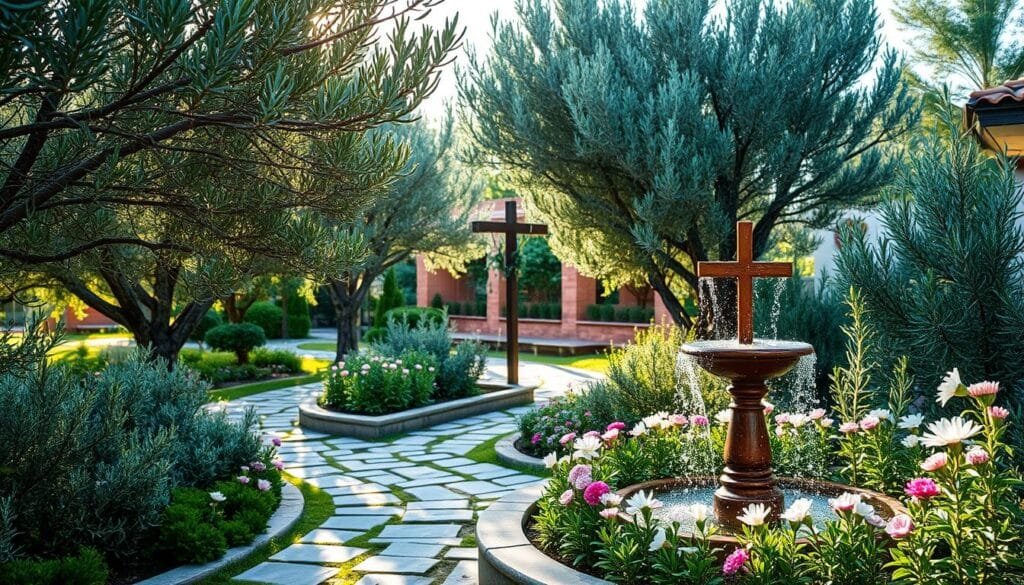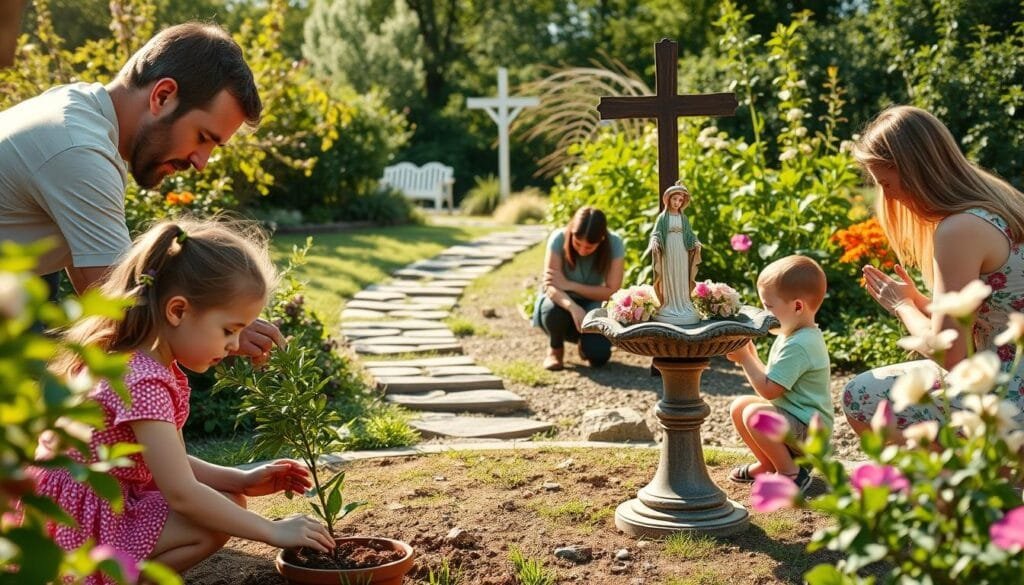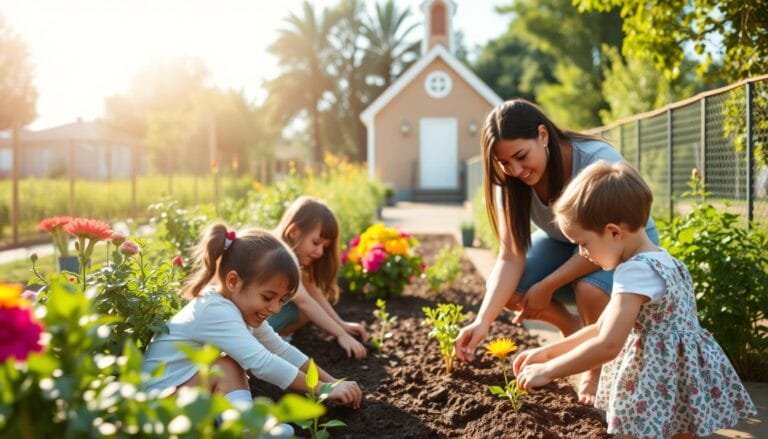Creating a Catholic Family Garden
This website contains affiliate links. As an Amazon Associate, I earn from qualifying purchases. The content on this website was created with the help of AI.
Can a garden teach your family about God’s love? A Catholic family garden is a place where faith and nature meet. It turns simple dirt and seeds into a space for growth.
A Catholic family garden is more than plants. It’s a sacred place filled with tradition. Start with a 3-foot Mary statue, available on Amazon.
- Blessed Mother Statues: Peaceful and full of grace, this lovingly-designed statue elegantly depicts mary statue in her l…
- Handmade Virgin Mary Gifts: Ideal for any religious holiday, baptism, housewarming blessing and so on, memorable gift of…
- Catholic Statues for Home: Saint mary statue is a great size to put on a shelf or table or anywhere in a home, office, o…

Add seven stones for the Holy Spirit’s gifts or Mary’s joys, along with marigolds and rosemary.
Even small spaces can be beautiful. Cinder blocks make great seating, and perennials like daylilies require little care. This ensures your garden stays lovely for years.
Children are perfect for gardening. Let them pick three fruits of the Holy Spirit to grow. Books like Gardening with Kids help them connect deeper. Soil preparation is also important, as seen in South Carolina with its red clay.
Key Takeaways
- A 3-foot Mary statue anchors the garden’s spiritual focus.
- Seven stones symbolize divine gifts, aligning with Catholic teachings.
- Choose blue flowers (like morning glories) and roses to honor Mary’s symbolism.
- Involve children in selecting three fruits of the Holy Spirit to grow together.
- Perennials reduce yearly work while reflecting God’s enduring love.
Planting with prayer and sharing harvests can inspire neighbors. The Catholic Icing Membership offers over 190 resources for garden rituals.
Gardening teaches us to care for souls as we do for plants. For a more spiritual bonding experience, check out our faith-filled game nights.
The Spiritual Foundation of a Catholic Family Garden
Starting a garden with faith means seeing plants and spaces as tools for growth. Our yards can reflect biblical teachings, helping families feel God’s presence in the natural world.
Add biblical plants, such as olive trees or figs, which are linked to Scripture. These plants turn your Catholic outdoor space
Biblical Gardens and Their Significance
Our gardens can be like Eden and Gethsemane, places where we meet God. Plant Catholic garden plants like lilies for Easter or rosemary for the Feast of the Annunciation.
Each flower becomes a moment to connect with Scripture. Imagine a prayer garden with a spot for sitting, where kids learn to see God in nature.
These areas help grow faith by mixing tradition with hands-on care.
Aligning Your Garden with the Liturgical Calendar
A liturgical garden follows the Church’s cycles. Plant marigolds for Our Lady’s days or winterberry hollies for Advent. Here’s how to align:
- Advent: Evergreens and poinsettias for hope
- Easter: White blossoms symbolizing Christ’s resurrection
- Lent: Lenten lilies bloom during this season
Choosing plants by season makes gardening a real way to practice faith. It helps families mark essential times of the year through nature.
Creating Sacred Space in Your Backyard
Make a corner of your yard a garden meditation area. Put a bench under a tree for quiet time.
Add a statue of Mary or a cross to make it holy. Even a simple wooden sign with the Our Father can make it a special moment.
As families pray together, they follow the Church’s teaching on faith in community. These spots become places where kids learn to hear God in nature, as the USCCB suggests.
Planning Your Catholic Family Garden
Every Catholic garden starts with careful planning. It honors God’s creation and meets family needs. Let’s create a space that reminds us of our faith every day.
Selecting a Location for Prayer and Reflection
Find a spot with the right mix of sunlight and shade. Most plants require 6+ hours of light, but also need a quiet, shaded area for prayer.
Even small spaces can have a garden—use window boxes or balcony containers.
Ensure it’s easy for everyone to access. It should be a place where families come together.
For inspiration, check out A Garden Catechism by Margaret Rose Realy. It suggests plants like lilies and irises.
Involving Children in the Design Process
Get every child involved in picking plants and designs. A wise mother once said:
“I like to make something like this a ‘family project’ and take everyone out to work together until the task is complete!”
Let them:
- Paint rocks with Bible verses or the names of saints.
- Choose a section for kids with easy-to-grow herbs like basil.
- Help make a small altar with thrift store religious statues.
Visit Catholic prayers for children to bless planting sessions. It makes work a family faith activity.
Budgeting and Resources for Faith-Based Gardens
Begin with simple steps: buy seeds instead of plants, and find affordable statues. Use old materials for walkways. Focus on unity and prayer, not perfection.
Add to your garden over time. Swap seeds with others or find secondhand items. Even small efforts, with God’s help, can turn ordinary places into sacred spaces.
Plants and Elements for Your Catholic Family Garden

Every plant and stone in your garden can share truths of our faith. Catholic garden plants, such as olive trees, symbolize peace, reminding us of Noah’s hope after the flood.
Biblical plants such as lilies show God’s care, just like Jesus taught in Matthew 6:28. Start by picking plants with roots in Scripture:
| Plant | Biblical Meaning |
|---|---|
| Olive | Gen 8:11 – olive branch of peace |
| Rosemary | Monastic herb for memory of Christ’s sacrifice |
| Lilies | Matthew 6:28-30 – beauty points to divine care |
| Almond | Num 17:8 – Aaron’s rod that blossomed |
Add elements that encourage reflection. A small cross path marker or a statue of St. Francis of Assisi can be a meaningful addition.
A simple fountain reminds us of baptism. Stones in a labyrinth pattern guide us in prayer walks.
Design with care for the harmony of nature. Pope Francis in Laudato Si’ (par. 70) says biodiversity honors God’s design.
Use 70% native plants to support local ecosystems. The Victory Noll Sisters offer grants of up to $1,000 for faith-based gardens.
Every plant choice is a chance to teach. When planting rosemary, talk about how monks used herbs for healing and prayer. Let’s make spaces where roots and faith grow together.
Faith-Building Activities in Your Catholic Family Garden
“Our Fairy Mary Garden is meant to be played with. My kids can rearrange the figures, houses, and tiny stepping stones to their hearts’ content, all while seeing Mary our mother is always watching over us.”

Make your garden a prayer space where faith and flowers flourish together. Start each season with a family devotional.
For example, bless new seedlings during Lent or celebrate Easter with rosemary sprigs for church altars.
Hands-on faith lessons are perfect here, such as rosary walks led by kids, crafting Advent wreaths with garden greens, or creating Stations of the Cross with clay figures.
Mark liturgical seasons with rituals like:
- Spring: Bless the soil with holy water before planting
- Summer: Evening prayers at dusk while watering plants
- Winter: Indoor seed-starting workshops paired with Advent Scripture readings
Discuss how tending the soil mirrors nurturing faith. Explain that just as plants need roots, we must uproot sins.
Planting peas and pole beans together shows how we rely on community, just like vines clinging to supports. Use parables like the mustard seed to explain faith’s invisible growth.
Share 10% of harvests with neighbors, mirroring the tithe. Let children weigh baskets while discussing Matthew 25:35.
Create family faith activities, such as making bread from homegrown wheat, to serve at parish festivals. Keep a shared journal noting each harvest’s spiritual lessons.
Over the decades, even small gardens have become heirlooms of faith. Our family’s two gardens across states remind us that God’s grace sustains us wherever we grow.
As Psalm 103 says, “He gives grass to the cattle,” teaching us the importance of stewardship. Every weeded row becomes a prayer in action.
Conclusion: Cultivating Faith Through Your Family Garden
Your Catholic family garden is more than just soil and seeds. It’s a place where faith grows. Pope Francis’ Laudato Si’ teaches us that caring for nature is sacred.
When 70% of Catholic parents see prayer routines strengthen their kids’ faith, your garden becomes a living example of this truth.
Begin with small steps: a pot of basil near a Mary statue, or a cross marking the corner of your yard.
Children’s curiosity is like our trust in God’s timing. This curiosity can help us understand God’s plan.
Summer is an excellent time for growth. Pair the Sacred Heart devotion in June with The Living Water Series.
Or, in July, connect Precious Blood with Ornamental Graces. The Holy Heroes program teaches lessons on perseverance and gratitude through gardening.
When 85% of families feel closer through shared service, even small acts like tending herbs become acts of love. These acts help us understand the value of community.
Use Lift Up Your Heart to guide your daily rosary by the marigolds. Alternatively, use garden harvests to teach about stewardship by donating to local food pantries.
Remember, 75% of children who plant seeds with their parents connect prayer more deeply with nature.
Whether through the 4 virtues in Blessed Is She’s program or weekly discussions on the Eucharist’s earthly roots, your garden becomes a classroom.
Here, faith and nature blend together.
Laudato Si’ reminds us that everything is connected. Your efforts, whether a single basil plant or a full Mary garden, make a difference.
Invite your children to bury a seed with a prayer. Tend the soil together, knowing 80% of kids who serve with family grow in empathy.
Let this garden be your family’s altar. Here, time in God’s creation strengthens your bond with Him and each other.
The Master Gardener works with us, turning our imperfect efforts into sacred ground.







